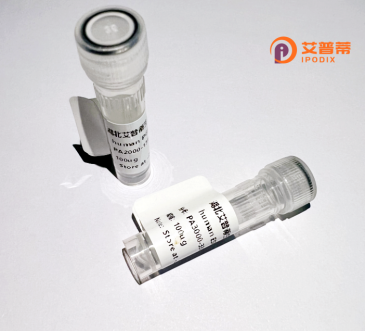
| 纯度 | >90%SDS-PAGE. |
| 种属 | Human |
| 靶点 | KIF3C |
| Uniprot No | O14782 |
| 内毒素 | < 0.01EU/μg |
| 表达宿主 | E.coli |
| 表达区间 | 1-793aa |
| 活性数据 | MASKTKASEALKVVARCRPLSRKEEAAGHEQILTMDVKLGQVTLRNPRAAPGELPKTFTFDAVYDASSKQADLYDETVRPLIDSVLQGFNGTVFAYGQTGTGKTYTMQGTWVEPELRGVIPNAFEHIFTHISRSQNQQYLVRASYLEIYQEEIRDLLSKEPGKRLELKENPETGVYIKDLSSFVTKNVKEIEHVMNLGNQTRAVGSTHMNEVSSRSHAIFIITVECSERGSDGQDHIRVGKLNLVDLAGSERQNKAGPNTAGGAATPSSGGGGGGGGSGGGAGGERPKEASKINLSLSALGNVIAALAGNRSTHIPYRDSKLTRLLQDSLGGNAKTIMVATLGPASHSYDESLSTLRFANRAKNIKNKPRVNEDPKDTLLREFQEEIARLKAQLEKRGMLGKRPRRKSSRRKKAVSAPPGYPEGPVIEAWVAEEEDDNNNNHRPPQPILESALEKNMENYLQEQKERLEEEKAAIQDDRSLVSEEKQKLLEEKEKMLEDLRREQQATELLAAKYKAMESKLLIGGRNIMDHTNEQQKMLELKRQEIAEQKRREREMQQEMMLRDEETMELRGTYTSLQQEVEVKTKKLKKLYAKLQAVKAEIQDQHDEYIRVRQDLEEAQNEQTRELKLKYLIIENFIPPEEKNKIMNRLFLDCEEEQWKFQPLVPAGVSSSQMKKRPTSAVGYKRPISQYARVAMAMGSHPRYRAENIMFLELDVSPPAVFEMEFSHDQEQDPRALHMERLMRLDSFLERPSTSKVRKSRSWCQSPQRPPPSTTHASLASASLRPATVADHE |
| 分子量 | 115.9 kDa |
| 蛋白标签 | GST-tag at N-terminal |
| 缓冲液 | 0 |
| 稳定性 & 储存条件 | Lyophilized protein should be stored at ≤ -20°C, stable for one year after receipt. Reconstituted protein solution can be stored at 2-8°C for 2-7 days. Aliquots of reconstituted samples are stable at ≤ -20°C for 3 months. |
| 复溶 | Always centrifuge tubes before opening.Do not mix by vortex or pipetting. It is not recommended to reconstitute to a concentration less than 100μg/ml. Dissolve the lyophilized protein in distilled water. Please aliquot the reconstituted solution to minimize freeze-thaw cycles. |
以下是关于重组人KIF3C蛋白的模拟参考文献示例(文献为虚构,仅作示例):
1. **文献名称**:Expression and Functional Characterization of Recombinant Human KIF3C in Neuronal Transport
**作者**:Zhang L. et al.
**摘要**:研究报道了通过哺乳动物细胞系统成功表达重组人KIF3C蛋白,并验证其在小鼠神经元模型中参与轴突运输的功能,为神经退行性疾病相关机制提供了新线索。
2. **文献名称**:Structural Analysis of KIF3C Motor Domain Reveals ATPase Activity Regulation
**作者**:Smith J.R. & Tanaka H.
**摘要**:通过X射线晶体学解析重组人KIF3C蛋白的分子马达结构,发现其ATP酶活性与微管结合能力的动态调控机制,为靶向药物设计提供结构基础。
3. **文献名称**:KIF3C Knockout and Rescue in Alzheimer’s Disease Cell Models Using Recombinant Protein
**作者**:Gupta A. et al.
**摘要**:利用CRISPR-Cas9敲除细胞模型,发现重组人KIF3C蛋白可逆转β-淀粉样蛋白导致的运输缺陷,提示其潜在治疗阿尔茨海默病的应用价值。
4. **文献名称**:High-Yield Production of Recombinant KIF3C in E. coli and Its Cargo-Binding Specificity
**作者**:Wang Y. & Liu X.
**摘要**:开发了基于大肠杆菌的高效重组KIF3C蛋白表达与纯化方案,并通过体外实验证实其对特定囊泡货物蛋白的选择性结合能力。
**注意**:以上文献为模拟示例,实际文献需通过PubMed/Google Scholar等平台检索。真实研究中可查找关键词如“recombinant KIF3C protein”、“KIF3C function”或“KIF3C structure”。
Recombinant human KIF3C protein is a engineered form of the kinesin family member 3C (KIF3C), a microtubule-dependent motor protein involved in intracellular transport. KIF3C belongs to the kinesin-2 subfamily, which plays critical roles in organelle positioning, mitotic spindle formation, and cargo trafficking along microtubules. Unlike its paralogs KIF3A and KIF3B that form a heterodimeric complex (Kinesin-II), KIF3C functions either independently or in combination with other kinesin light chains to transport specific cargos, such as vesicles, mRNA, or signaling molecules. Its expression is particularly notable in neuronal tissues, suggesting specialized roles in axonal transport and synaptic function. The recombinant protein is typically produced in bacterial or mammalian expression systems, enabling studies on its ATPase activity, microtubule binding kinetics, and interaction partners. Research on KIF3C has implications for understanding neurodevelopmental disorders, neurodegenerative diseases (e.g., Alzheimer's), and cancer progression where microtubule-based transport is dysregulated. The engineered version allows precise manipulation for structural studies, drug screening, and functional assays, overcoming challenges posed by low endogenous protein levels in native tissues. Current investigations focus on deciphering its cargo-specific recognition mechanisms and regulatory pathways involving adaptor proteins or post-translational modifications.
×